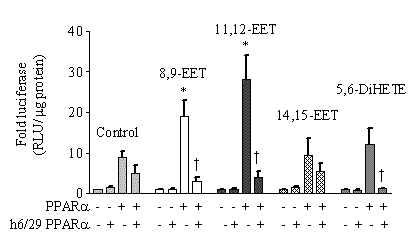| pA2 online © Copyright 2004 The British Pharmacological Society |
082P
GKT, University of London Winter Meeting December 2003 |
|
8,9- and
11,12-EETs are potent activators of peroxisome proliferator-activated
receptor- |
|
Peroxisome proliferator-activated
receptor (PPAR)-a is a fatty acid-activated nuclear receptor with roles
regulating lipid metabolism, proliferation and inflammation (Bishop-Bailey,
2000). We have previously shown that CYP2J2, an abundant epoxygenase in
human cardiovascular and pulmonary systems, activates PPARa (Wray et al.,
2003). We have therefore, investigated products of CYP2J2 on PPAR![]() mediated transcriptional activation.
mediated transcriptional activation.
Human embryonic kidney
cells (HEK)293 were maintained in DMEM supplemented with antibiotics/
anti-mycotics and 10% FCS (37°C; 5% CO2;
95% air). Cells were transfected with combinations (0.5µg of each)
of pACO.luc PPAR luciferase reporter gene, mPPAR![]() or dominant negative PPAR
or dominant negative PPAR![]() (h6/29; a gift from Dr. Ruth Roberts; AstraZeneca) using NovaFector, as
described previously (Wray et al., 2003). Cells were then incubated with
1µM of 8,9-, 11,12-, 14,15 epoxyeicosatrienoic acid (EET), or 5,6-dihydroxyeicosatrienoic
acid (DiHETE) for 16h. Cells were then lysed, and luciferase activity
measured and normalised to protein content (Wray et al., 2003).
(h6/29; a gift from Dr. Ruth Roberts; AstraZeneca) using NovaFector, as
described previously (Wray et al., 2003). Cells were then incubated with
1µM of 8,9-, 11,12-, 14,15 epoxyeicosatrienoic acid (EET), or 5,6-dihydroxyeicosatrienoic
acid (DiHETE) for 16h. Cells were then lysed, and luciferase activity
measured and normalised to protein content (Wray et al., 2003).
Transfection of PPAR![]() alone induced PPAR transcriptional activation. 8,9-, and 11,12-EET did
not effect transcriptional activation alone, but significantly induced
PPAR activation in the presence of PPAR
alone induced PPAR transcriptional activation. 8,9-, and 11,12-EET did
not effect transcriptional activation alone, but significantly induced
PPAR activation in the presence of PPAR![]() .
These effects were abolished when dominant negative h6/29PPAR
.
These effects were abolished when dominant negative h6/29PPAR![]() was present (figure 1). 14,15-EET or 5,6-DiHETE did not effect PPAR activation
under any condition tested (figure 1).
was present (figure 1). 14,15-EET or 5,6-DiHETE did not effect PPAR activation
under any condition tested (figure 1).

Figure 1. 8,9-EET
and 11,12 EET-activate PPARa mediated reporter gene (fold luciferase/µg
protein). HEK293 cells were transfected with pACO.luc, pCMX-mPPAR![]() and/or h6/29PPAR
and/or h6/29PPAR![]() .
Activation was measured after 16h of incubation with 8,9-, 11,12-, 14,15-EET
or 5,6-DiHETE (all 1µM). Data represents mean ± SEM of n=9
from 3 experiments. * indicates p<0.05 by Wilcoxon matched pairs test
between PPARa in the absence and presence of drug treatment and † indicates
p<0.05 by Wilcoxon matched pairs test between treatment in the presence
or absence of h6/29PPAR
.
Activation was measured after 16h of incubation with 8,9-, 11,12-, 14,15-EET
or 5,6-DiHETE (all 1µM). Data represents mean ± SEM of n=9
from 3 experiments. * indicates p<0.05 by Wilcoxon matched pairs test
between PPARa in the absence and presence of drug treatment and † indicates
p<0.05 by Wilcoxon matched pairs test between treatment in the presence
or absence of h6/29PPAR![]() .
.
The CYP2J2 products
8,9- and 11,12-EET activate PPAR![]() .
CYP2J2 products may represent novel endogenous mediators for PPAR
.
CYP2J2 products may represent novel endogenous mediators for PPAR![]() activation and its subsequent vascular/pulmonary anti-inflammatory and
anti-proliferative effects.
activation and its subsequent vascular/pulmonary anti-inflammatory and
anti-proliferative effects.
Bishop-Bailey, D.
(2000). Br. J. Pharmacol. 129, 823-34.
Wray, J.A., et al. (2003). Br. J. Pharmacol. 138,
169P.
Funded by the William Harvey Medical Research Foundation and the BHF (BS/02/002).